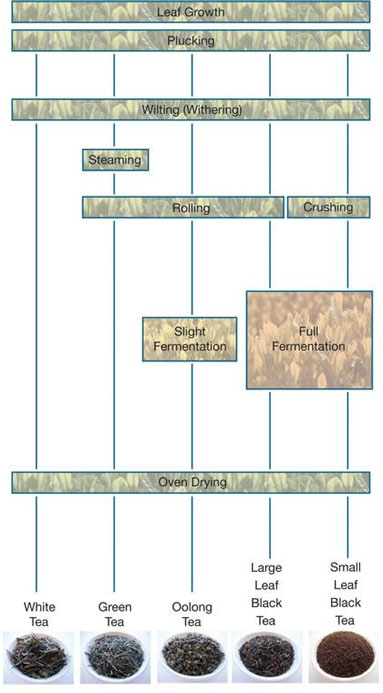- Home
- Sample Graphs
- Ielts Process Writing Sample
IELTS Process Writing Sample
In this IELTS process writing sample, the manufacture of tea is described.
A process diagram is different to a graph or chart and requires some different language structures (though you still need to compare and contrast the various stages in the process where possible).
Particular language structures that you need to be aware of are the passive and time phrases.
Now, take a look at this question and the tea process below, and then study the model answer and comments below.
IELTS Process - Tea Production
You should spend about 20 minutes on this task.
The diagram shows how tea leaves are processed into five tea types.
Summarise the information by selecting and reporting the main features and make comparisons where relevant.
Write at least 150 words.
IELTS process writing sample answer
The diagram presents the manufacture of five different types of tea. It is immediately apparent that although all the teas are produced from the same leaf, the differences in the manufacturing process result in five different types of tea.
The first three stages of manufacture are the same for all of the five teas. The leaves are grown, they are then plucked, and following this withering of the leaves occures. The final stage is also the same, which sees all the leaves dried in an oven. However, in the stages in between this, differing methods of production are employed.
To begin, white tea is unique as it involves no other processing. In contrast, green, oolong and large leaf black tea are all rolled as part of the process. However, while green tea is steamed before being rolled but is not fermented, the other two teas are first rolled and then both fermented (oolong only slightly but large leaf black completely). Finally, small leaf black tea is neither steamed nor rolled, but is crushed before being fully fermented.
(177 Words)
Comments
This IELTS process writing sample is a well-organized response that covers all the important features of the diagram.
It is easy to follow as it discusses each tea in turn, but not only this, it also groups similar processes together and identifies the differences.
For example:
Similarities:
The first three stages of manufacture are the same for all of the five teas.
…green, oolong and large leaf black tea are all rolled as part of the process.
Differences:
…white tea is unique as it involves no other processing.
However, while green tea is steamed before being rolled but is not fermented, the other two teas are first rolled and then both fermented.
The candidate decides to mention the first three stages and the last one together in one paragraph as they are exactly the same for every tea, and the differing stages in the middle following this.
This may seem odd to mention the stages in this order, and it is likely that when you describe a process you will discuss each stage in turn, but for this particular process it works well as the candidate can then focus on the differences.
The appropriate voice is also used in the description, which is the passive.
When we write about a process, we are interested in the actions, NOT who is doing them. In this case we use the passive voice. Here are some examples of the passive voice from this IELTS writing sample process:
...the teas are produced from the same leaf
The leaves are grown, they are then plucked
...differing methods of production are employed
It may not always be possible, but if you can you should also try to use synonyms for some of the words from the diagram rather than copying them all.
For example, ‘completely’ fermented is used instead of ‘fully’.
Make sure you also make use of a mix of ‘time’ transitions to guide the reader through the description:
…they are then plucked, and following this withering of the leaves occures.
…the other two teas are first rolled and then both fermented
The candidate also demonstrates the ability to accurately use a mix of complex structures necessary to achieve above a band 6 for ‘grammatical range and accuracy’:
Noun Clauses:
It is immediately apparent that although all the teas are produced from the same leaf...
Relative Clauses:
The final stage is also the same, which sees all the leaves dried in an oven.
Adverbial Clauses:
…although all the teas are produced from the same leaf
…white tea is unique as it involves no other processing.
…while green tea is steamed before being rolled but is not fermented,
See the IELTS grammar page for an explanation of what is required for grammar in writing task 1 and 2.
You can view a lesson on writing about a process and use of the passive and time phrases here.
Comments
Any comments or questions about this page or about IELTS? Post them here. Your email will not be published or shared.
















